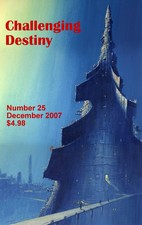


Reviews Home
Columns
Fiction by Title
Fiction by Author
Nonfiction
Movies by Title
Movies by Rating
Audio
Games
The Quantum Rose, Catherine Asaro, TOR, 2000, 398 pp.
With The Quantum Rose, Catherine Asaro continues her resourceful practice of filling in the gaps of her future history. This time around, Asaro does not use a viewpoint character that the reader is already familiar with (such as Sauscony Valdoria of Primary Inversion and The Radiant Seas, and Kelric of The Last Hawk), and the story is stronger for that fact. The main character of The Quantum Rose is a woman named Kamoj, and while she encounters a Skolian in the course of the story, she has an outlook on life that is worlds apart from the Skolian outlook that Asaro has explored in her other books. The Quantum Rose also demonstrates that an idea common in the genre can be quite effective when it's in the context of a well-written story. Many science fiction books have used the cliché of the primitive society which was once advanced and has now lost the understanding of most technology. Asaro overcomes initial resistance to the premise by focusing on the people in the story.
Kamoj is governor of Argali Province. She is engaged to marry Ironbridge, the governor of the eponymous neighbouring province, but Ironbridge is abusive, egotistical, and selfish. A strange new aristocrat, Lionstar, has rented some land and a palace from Argali, and soon Lionstar makes Kamoj a marriage offer. Kamoj goes to live with Lionstar, and begins to find out about this strange man. Is she in love? Perhaps, but Ironbridge, the villainous scumbag that he is, does not shy away from violence. What follows is some standard woman-in-peril shenanigans, but Asaro uses it to critique the society of Argali and Ironbridge, and simultaneously poke a few holes in the non-interference policy of the Skolians.
Because Lionstar is, of course, a Skolian. The reader doesn't know that immediately, and we follow Kamoj's process of discovery with the same sense of wonder as she does herself. Lionstar's real name is Vyrl, and he is a member of the Skolian imperial family and one of the most sensitive telepaths in the galaxy. In a crucial scene, Vyrl shares some of his past with Kamoj, and it is as wrenching an indictment of politics as could be possible: Vyrl was supposed to be smuggled off an interdicted planet in his father's coffin, but pickup was delayed, leaving him in a torment of sensory deprivation. The Skolian politicians could have ended his agony but that would have meant losing control of him again. Vyrl is only rescued after a month; suffice it to say that he has good reason for his psychological problems. Thankfully, Asaro doesn't let Kamoj be responsible for fixing Vyrl's personal difficulties.
The second half of the book deals with Skolian problems and Vyrl's family, and in particular a rousing non-violent showdown that depends on Vyrl's leadership and the civil disobedience of his people. The storyline remains effective, but seems less connected to what was happening in the first half. The Quantum Rose has much the same narrative structure as Asaro's second novel, Catch the Lightning, where the first half of the novel told of events on the female character's planet and the second half on the male's. The Quantum Rose ties the two halves of the story together by way of character development, the ongoing relationship between Kamoj and Vyrl. The book fits in quite tightly with Asaro's future history (The Quantum Rose follows the events of The Radiant Seas) so those fans who want to find out what happens next in the saga will find this book fulfilling.
Asaro includes an Author's Note at the close of the book. Throughout the book, Asaro used subtitles for each chapter heading, and they are all part of an elaborate scheme for describing the action of the book with terminology from quantum scattering theory. The names of the people on Kamoj's planet are also based on terms from physics, so this adds an extra layer to the story. Asaro also discusses the overall organization of her Skolian Saga so far, which will be quite fascinating for fans of the series. And I like how Asaro concludes the note:
So this arc of stories deals with two themes: how humans seek freedom and how coming to appreciate cultural differences may help make the world more peaceful. The idea of understanding the "other" is, I think, a major aspect of science fiction. We look at what is different -- the alien -- and in doing so, perhaps better understand ourselves. (391)
The Quantum Rose is essential reading for fans of Asaro's future history. I found the first half more interesting, before the book submerges itself in that history -- those who haven't read Asaro's other books might find themselves at a loss in the second half of the book. The Quantum Rose won the Nebula Award for Best Novel in 2001.
First posted: March 31, 2001; Last modified: February 13, 20004
Copyright © 2001-2004 by James Schellenberg (james@jschellenberg.com)

Buy back issues of Challenging Destiny online from:
For the latest information on availability: Where Can You Buy Challenging Destiny?